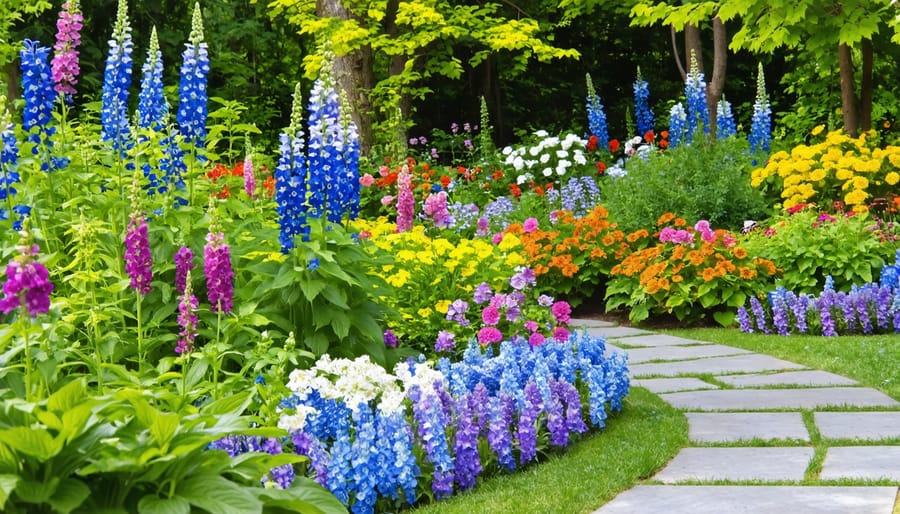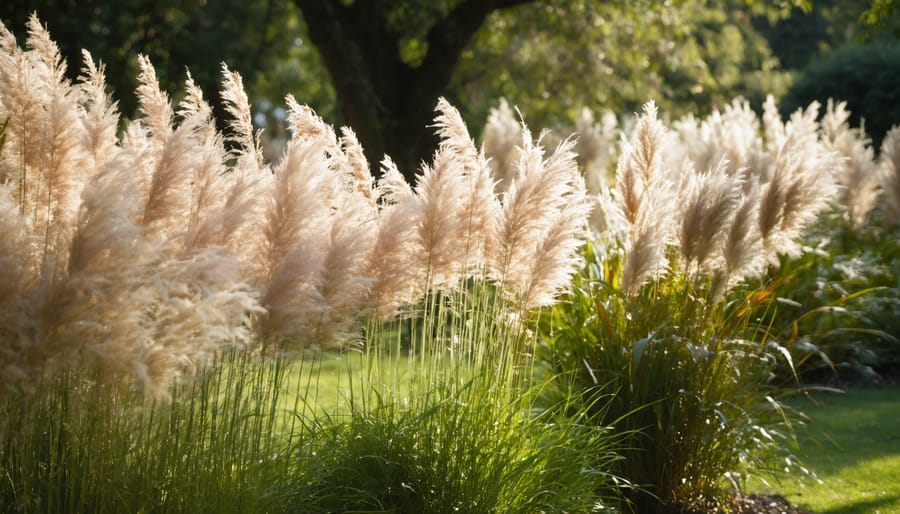Transform any garden space into a thriving perennial paradise by mapping your garden’s sun exposure patterns first – documenting which areas receive full sun, partial shade, or deep shade throughout the growing season. Group plants with similar water and soil requirements together, creating distinct “zones” that streamline maintenance and support optimal year-round perennial care. Layer your garden design with varying heights, positioning taller specimens like delphiniums and hollyhocks at the back, medium-height plants like coneflowers in the middle, and low-growing varieties such as creeping phlox along borders. Select plants that bloom in different seasons, ensuring continuous color from early spring through late fall – combine spring bulbs, summer perennials, and late-season bloomers like asters and chrysanthemums for uninterrupted visual interest.
This thoughtful approach to perennial garden planning creates a sustainable, low-maintenance landscape that matures beautifully over time, rewarding gardeners with increasingly spectacular displays each passing season. Whether you’re working with a small urban plot or an expansive country garden, these foundational planning principles ensure success.
Setting Your Perennial Garden’s Foundation
Understanding Your Garden’s Conditions
Before selecting your perennial plants, it’s essential to understand your garden’s unique conditions. Start by examining your soil type – is it clay, sandy, or loamy? Grab a handful of moist soil and squeeze it. If it holds its shape but crumbles easily, you’ve got ideal loamy soil. If it’s sticky and dense, you’re working with clay, while sandy soil feels gritty and falls apart quickly.
Next, observe your garden’s sunlight patterns throughout the day. Some areas might receive full sun (6+ hours), while others might be perfect for plants for shaded areas. Make a simple sun map by sketching your garden and noting sunny and shady spots at different times.
Your climate zone is another crucial factor. Check your local hardiness zone map – this will guide your plant selection and help ensure your perennials survive winter. Remember that microclimates within your garden, like areas near walls or under trees, can create slightly different growing conditions.
Don’t forget to test your soil’s pH level using a simple home testing kit. Most perennials prefer slightly acidic to neutral soil (pH 6.0-7.0). Understanding these basic conditions will help you choose plants that will thrive in your specific garden environment, leading to a more successful and enjoyable gardening experience.
Mapping Your Space
Before planting your first perennial, take time to map out your garden space carefully. Start by measuring your garden area and creating a simple sketch on graph paper, where each square represents one foot. This visual tool will become your garden’s blueprint and help prevent overcrowding as your plants mature.
Consider the mature size of each plant when planning their placement. A common mistake is placing plants too close together, leading to competition for resources and poor growth. Most perennials need 2-3 feet of space between them, though some larger varieties may require more. Remember that while your garden might look sparse initially, plants will fill in the spaces as they grow.
Take note of existing features like trees, structures, and pathways. These elements affect sunlight patterns and root competition. Create zones within your garden based on light conditions – full sun, partial shade, and full shade areas should be clearly marked on your plan.
Think about maintenance access too. Include paths or stepping stones that allow you to reach all plants for watering, weeding, and pruning. A good rule of thumb is to keep bed widths no more than 4-5 feet deep so you can easily reach the middle from either side.
Layer your plantings by height, with taller perennials at the back of borders and shorter ones in front. This creates visual interest and ensures smaller plants aren’t overshadowed by their larger neighbors.
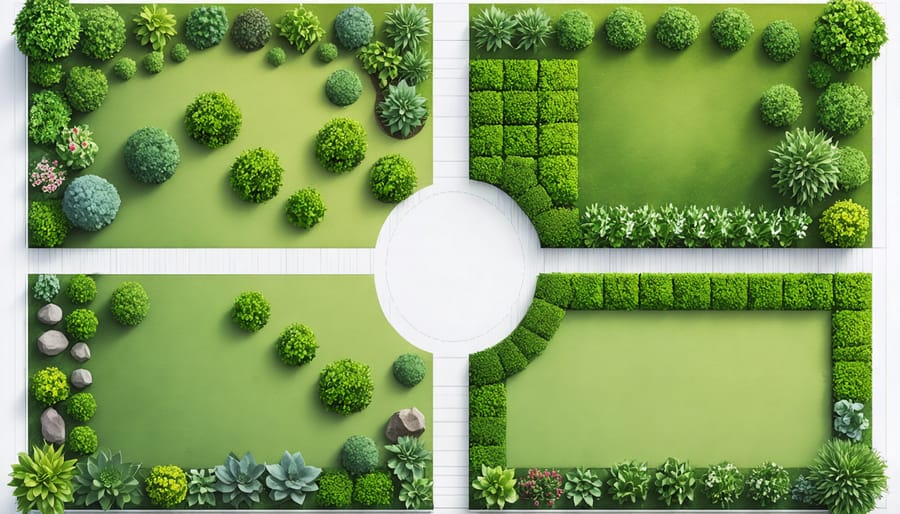
Selecting Plants for Continuous Blooms
Bloom Time Planning
Creating a garden that blooms continuously throughout the growing season is like orchestrating a beautiful symphony of colors. The key to achieving this endless display lies in thoughtful bloom time planning. Start by mapping out your garden’s flowering schedule across spring, summer, and fall to ensure there’s always something in bloom.
For early spring, consider reliable performers like crocuses, daffodils, and hellebores to kick off the season. As spring progresses, incorporate mid-season bloomers such as bleeding hearts, columbines, and iris varieties. Late spring brings the opportunity to showcase peonies and alliums, creating stunning focal points in your garden.
When summer arrives, transition to summer-blooming daylilies, coneflowers, and salvias. These hardy performers provide weeks of color and attract beneficial pollinators to your garden. For mid to late summer, include black-eyed Susans, bee balm, and garden phlox to maintain visual interest.
Don’t forget about fall blooming options! Sedums, asters, and Japanese anemones carry the show well into autumn, providing both color and structure as the season winds down. Consider including some ornamental grasses that reach their peak beauty in fall, adding movement and texture to your garden.
To keep track of bloom times, create a simple calendar noting when each plant typically flowers in your region. Group plants with similar bloom periods together to create impactful displays, but also mix in plants from different periods to ensure continuous color throughout your garden. Remember that bloom times can vary slightly depending on your local climate and weather conditions.
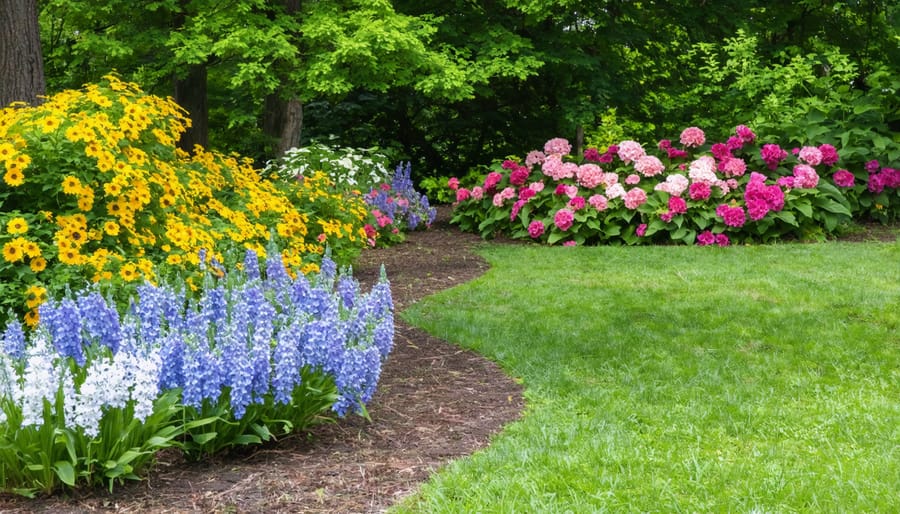
Color and Texture Combinations
Creating striking color and texture combinations in your perennial garden is like composing a living work of art that changes throughout the seasons. Start by selecting plants with contrasting foliage textures – pair feathery, fine-leaved plants like Russian Sage with bold, broad leaves such as Hostas. This contrast creates visual interest even when flowers aren’t blooming.
When planning color schemes, consider using the color wheel as your guide. Complementary colors (those opposite each other on the wheel) create dramatic impact – think purple Salvias against yellow Black-eyed Susans. For a more peaceful feel, choose analogous colors, such as combining different shades of blue, purple, and pink with plants like Delphiniums, Catmint, and Garden Phlox.
Don’t forget about silver and gray foliage plants, which act as natural mediators between bold colors. Lamb’s Ear and Artemisia can soften transitions between vibrant flower groups while adding interesting texture. Consider height variations too – tall, spiky flowers like Foxgloves look stunning when paired with low-growing, mounding plants like Coral Bells.
Remember that texture isn’t just about leaves – incorporate plants with interesting seed heads, like Coneflowers and Ornamental Grasses, which add winter interest long after blooms have faded. Layer your plantings by placing fine-textured plants in front of coarse-textured ones to create depth and dimension.
For year-round appeal, include plants with varying bloom times and interesting foliage colors. Mix evergreen perennials with deciduous ones to maintain structure throughout the seasons, ensuring your garden remains visually engaging even during dormant periods.
Maintenance Strategies for Long-Term Success
Seasonal Care Calendar
A successful perennial garden thrives on consistent care throughout the year. Let’s walk through the essential tasks for each season to keep your garden blooming beautifully.
Spring (March-May):
• Remove winter mulch gradually as temperatures warm
• Clean up dead foliage and trim back old growth
• Divide overcrowded plants before new growth emerges
• Start feeding your perennials with balanced fertilizer
• Add fresh mulch after soil warms
• Monitor for early-season pests
Summer (June-August):
• Water deeply during dry spells, preferably in early morning
• Deadhead spent blooms to encourage more flowers
• Stake tall plants before they flop
• Continue weeding regularly
• Watch for signs of disease or pest problems
Fall (September-November):
• Plant new perennials 6-8 weeks before first frost
• Cut back spent foliage after first frost
• Leave ornamental seed heads for winter interest
• Apply winter mulch after ground freezes
• Clean and sharpen tools
Winter (December-February):
• Monitor mulch levels around plants
• Check for frost-heaved plants
• Plan next season’s additions and changes
• Order seeds and plants for spring
• Maintain good snow cover for insulation
Remember that timing may vary depending on your climate zone. Keep a garden journal to track what works best in your specific location and adjust these guidelines accordingly. This calendar serves as a framework that you can customize based on your garden’s unique needs and your local weather patterns.
Division and Propagation
One of the most rewarding aspects of perennial gardening is the ability to multiply your plants through division and propagation. Not only does this practice help maintain healthy plant populations, but it also allows you to expand your garden without additional costs.
Most perennials benefit from division every 3-5 years, typically when they begin to show signs of reduced flowering or develop bare spots in the center. The best time for division is usually early spring or fall, when temperatures are mild and plants can establish new roots before extreme weather sets in.
To divide perennials, start by digging up the entire plant and gently separating it into smaller sections, ensuring each division has healthy roots and several growth points. Use clean, sharp tools to make clean cuts, reducing the risk of disease. Some plants, like daylilies and hostas, can be pulled apart by hand, while others may require careful cutting with a spade or knife.
Many perennials can also be propagated through other methods. Stem cuttings work well for plants like phlox and chrysanthemums – simply take 4-6 inch cuttings from healthy stems and root them in moist potting soil. Some plants readily self-seed, and you can collect and store these seeds for future planting or allow them to naturally spread throughout your garden.
Remember to water newly divided or propagated plants thoroughly and provide extra care until they’re established. Share extra divisions with friends and neighbors – it’s a wonderful way to build community while expanding everyone’s gardens.
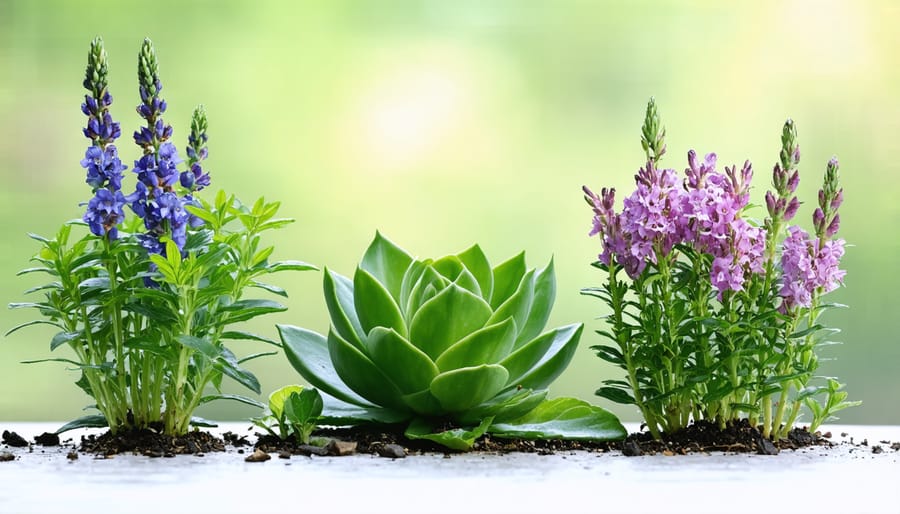
Problem Prevention
A successful perennial garden starts with prevention, and a few smart practices can help you avoid common pitfalls. Start by testing your soil annually to ensure proper pH levels and nutrient content. Many perennial problems stem from poor soil conditions, so maintaining healthy soil is your first line of defense.
Proper spacing is crucial – while it’s tempting to pack plants closely for immediate impact, overcrowding leads to poor air circulation and increased disease risk. Give each plant enough room to reach its mature size, and you’ll prevent many fungal issues before they start.
Watch for early signs of pest problems by inspecting your plants weekly. Look under leaves and along stems for unusual spots, holes, or insect activity. Installing beneficial insect habitats, like pollinator hotels and bird baths, helps create a natural pest control system in your garden.
Mulching is another preventive powerhouse. Apply a 2-3 inch layer of organic mulch around your perennials, keeping it away from stems to prevent rot. This helps suppress weeds, retain moisture, and regulate soil temperature.
Division is often overlooked but vital for prevention. Many perennials need dividing every 3-4 years to prevent overcrowding and maintain vigor. Mark your calendar to divide spring-blooming plants in fall and fall-blooming plants in spring.
Remember to clean your gardening tools regularly and remove dead foliage promptly to prevent disease spread. These simple habits can make a significant difference in your garden’s long-term health.
Creating a perennial garden is an exciting journey that rewards you with years of beautiful blooms and evolving landscapes. By following the planning principles we’ve discussed, you’ll be well-equipped to create your own stunning garden that returns year after year with increasing beauty and maturity.
Remember to start with a thorough site analysis, considering factors like sunlight, soil conditions, and drainage. Take time to research and select plants that not only thrive in your specific climate but also complement each other in height, bloom time, and color. Your garden’s success largely depends on this careful planning phase.
Don’t forget the importance of proper spacing and grouping plants with similar needs together. This thoughtful arrangement will make maintenance easier and ensure your garden looks balanced as it grows. Consider incorporating paths and focal points early in your planning to create an engaging garden experience.
Most importantly, be patient. Perennial gardens are a long-term investment that improves with time. While they may take a few seasons to reach their full potential, the wait is well worth it. Start small if you’re feeling overwhelmed – you can always expand your garden as your confidence grows.
Whether you’re planning your first perennial bed or redesigning an existing space, remember that gardening is a creative process that allows for experimentation and personal expression. Take these guidelines as a foundation, but don’t be afraid to adapt them to suit your unique vision and garden dreams.

